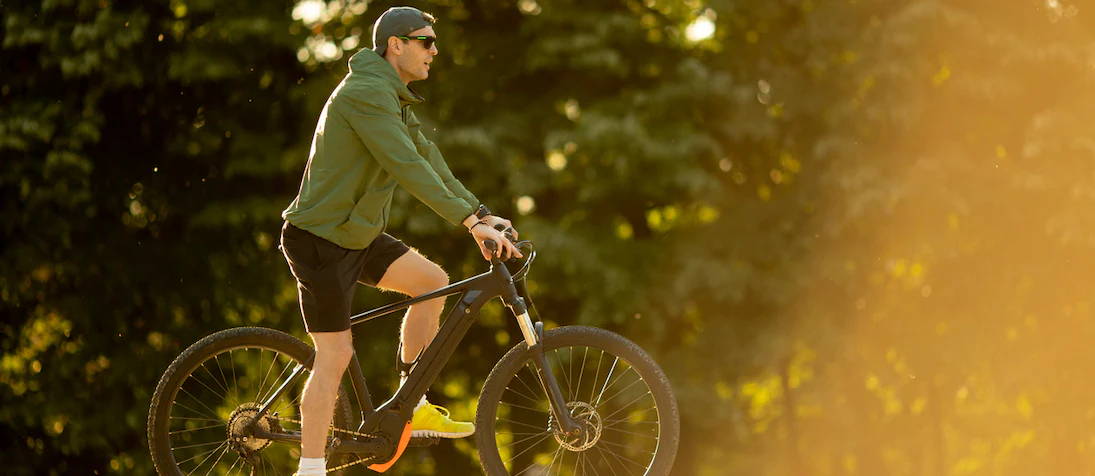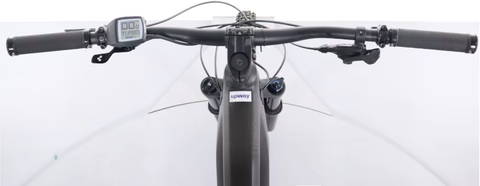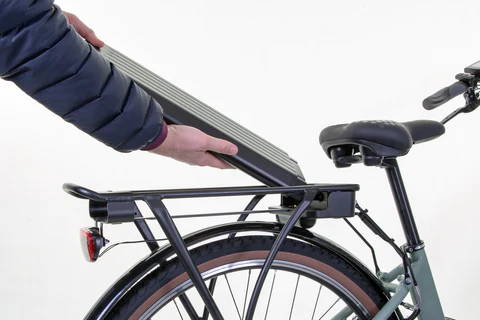How does an electric bicycle work?

The electric bike is handled just like a conventional bicycle. Except for one detail... It combines human strength with the power of a (silent) electric motor. With each pedal stroke, the effort required to move forward is reduced. Gaining speed has never been so easy! Mind you, your power is increased tenfold, but not replaced. Don't dream: an electric bike doesn't go by itself!
An electric bike motor provides efficient assistance up to a speed of 25 km/h (or even 45 km/h for a speedbike). In this way, a steep hill becomes less steep, and headwinds less difficult to combat. You travel faster, further, with less fatigue.
Whether you're looking for a cleaner way to get to work, or a way to tackle steep inclines, an electrically-assisted bike is a great way to reduce your physical effort. How does an electric bike work? Can you ride an electric bike without assistance? We answer your questions by reviewing the main components of an EAB.
The functioning of the different components of the electric bicycle
Let's take a closer look at how it works! The first element to come into play is the pedaling or torque sensor. The motor detects the power you're developing or the speed of your wheels, and provides linear or proportional assistance (the harder you pedal, the more the motor helps you).
There are several types of motorization: pedal motor, motor located in the front or rear wheel.
Pedal motors tend to be more responsive, as they adapt to your efforts for optimum rotation speed. They are generally more powerful, but put more strain on the transmission system (chains, sprockets, etc.) and brakes (because you're going faster...).
The motors in the wheel, on the other hand,do not detect the power of your legs. They rely on rotation sensors. The assistance provided is less natural, and more energy-consuming.
As mentioned in the introduction, an electric bike doesn't move on its own (otherwise, it's almost like an electric scooter...). The power-assisted bike will assist your pedaling. It increases your natural power tenfold. Power comes from the battery, which is generally located on the frame, in the frame or on the luggage rack.
Many batteries can be removed for charging, while others need to be charged directly on the bike. If this is the case, you'll need a place to park the bike close to a power outlet.
Note also that the energy required varies according to the assistance mode selected:
- Eco mode: assists you at up to 50% for extended battery life.
- Tour mode : useful on winding roads, this mode delivers 120% of your power.
- Turbo mode: the engine delivers maximum energy, 300%, at the expense of battery life.
To enable you to select the level of assistance, there is usually a control screen located on the handlebars or integrated into the frame. It's on this screen that you'll also find battery level information.
Some electric-assist bikes have more advanced options, such as navigation, fitness tracking, distance traveled, the ability to export trip data to a computer, and many other features.

The essentials of an electric bike
Some electric bikes come with a myriad of features, such as integrated lights to secure your night outings, a GPS navigation system or stylish mudguards. While nice, these are not key features of an electric bike. What it really needs is a good motor, battery, sensors, frame and brakes.
The engine: the invisible force
The motor is undoubtedly one of the key components in the smooth operation of an electric bicycle. There are several types of motor. The most common are the crankset motor and the hub motor. A hub motor is integrated into the bike's front or rear wheel.
The type of motor on your electric bike will have an impact on its efficiency, durability and feel:
- Front-wheel motor: this is the simplest and least expensive location. Installation does not interfere with the chain or pedals. A motor in the hub of the front wheel works with a speed sensor to provide detailed assistance. After a "stop", a "give way" or a traffic circle, restarting is easy. On the other hand, beware of slippery surfaces and white stripes in the rain. These can slightly destabilize the bike.
- Rear wheel hub: integrated into the bike's gears. This type of motorization provides a feeling of propulsion. Power transmission is efficient, but unfavorable leverage ratios inside the motor can lead to overheating on long climbs. However, this type of engine is suitable for all types of terrain, whether for touring or urban use. It's also less prone to falling off when it's raining, as rear-wheel gearing is generally better managed than front-wheel gearing.
- Pedal motor: here, the electric motor is located close to the pedals, in the center of the bike. The EAB is stable and maneuverable, and assistance is proportional to the pressure you exert on the pedals. These motors are installed on the best electric bikes: from city bikes to top-of-the-range MTB electric bikes. Perfect for medium and long distances!
But how do you set the motor's power? That's easy! Generally speaking, an electric bike has a maximum of 4 assistance levels that can be selected via the controller. So you'll be just as at ease on the flat as on the slopes, and you'll be able to pick up the pace effortlessly if you're late for a meeting (but always be careful!).
Electric-assist bicycle batteries
Without the battery, an electric bike is just another bike. The battery powers the motor, and dictates the overall range. It's what gets you where you want to go! In a way, it's the tank.
We generally use several units of electrical measurement: power, voltage and ampere-hours. These values will enable you to choose your EAB battery according to its capacity. Note that most electric bike batteries have a capacity of around 250 Watts.
To prevent this heavy part of the bike from upsetting your balance, it has a low, centered position. Although batteries have shrunk in size and increased in power since the advent of lithium in place of lead, they still contribute significant weight to your bike. That's why you can't use just any battery on an electric bike. It must offer an excellent power-to-weight ratio.
Lithium-ion batteries are lightweight but expensive. They can power your bike for dozens and dozens of kilometers on a single charge. It takes around 3 to 6 hours to recharge them using conventional plugs. Like a cell phone, all you have to do is plug it into the wall!
Of course, if your battery fails while riding, it is possible to ride without electric assistance, but the weight of the EAB will be felt. Pedaling will not be impossible, but more complicated.
How do the batteries work? It depends on the type of electric bike you have:
- Pedal assistance: pedaling starts the motor, increasing your speed and power. The speed of the bike decreases as the pedals slow down. This is a popular type of electric bike because cyclists can always control the power they get from the motor. In other words, they retain control and don't let the bike do all the work.
- Electric-only : powered by a gas pedal, electric-only bikes need no human energy to move. In fact, they are classified as mopeds. These electric "bikes" quickly discharge the battery and require more safety rules. Riding them is similar to riding a scooter.

It may also be useful to know how to test an electric bike battery. All you need is a multimeter.
Chassis and transmission
An ordinary bike usually has an aluminum frame, making it very light for greater efficiency. The same applies to high-quality electric bikes: the lighter the frame, the faster the bike. The spokes must be strong enough to resist bending or breaking, mainly because the electric bike has more torque (the power that makes it go).
Transmission refers to pedals, chainrings, cranks, chain and sprockets. All these parts work together to power your electric bike. A pedal motor powers the transmission directly, so you can shift gears and pedal more easily. This is another reason why pedal motors are so popular with efficiency-seeking cyclists. On the other hand, this type of motor obviously puts more strain on the transmission.
The brakes
Electric-powered bicycles can easily reach high speeds, and weigh more than conventional bikes, both factors justifying the use of an adapted braking system.
- Hydraulic disc brakes are a favorite of the electric bike community. They stop quickly in all weathers.
- Pad brakes require very little maintenance and have good stopping power, but not as much as hydraulic disc brakes. They are mounted on the bicycle hub or rim, and are activated by a cable. Over time, this type of brake tends to disappear.
The controller
It acts as the brain of the system. It is the link between the bike's motor, the battery and the various components. Its purpose is to regulate the intensity of the electrical signal.
The different types of electric assistance for bicycles
As electric bikes gain in popularity, pedal-assist systems are becoming the norm. They generate power for the transmission via the pedals.
There are two main types of electric assist system.
Non-proportional assistance: pedalling sensor
The magnetic pedaling sensor, also known as the rotation sensor, triggers continuous power assistance when the magnets attached to the crankset are detected by the sensor. It stops when you stop.
The pressure exerted on the pedals will have no impact on the motor's efficiency, and will not adapt to the terrain. It's up to you to select the level of assistance you need: eco, tour, turbo.
Proportional assistance: the pressure sensor
A simple touch of the pedal triggers torque-sensor assistance. It's an instant start!
This assistance detects the natural power developed and signals to the motor the power to deliver accordingly. Riding your EAB will be child's play, with no jerks or difficulties. Assistance is more natural. It's mainly found on top-of-the-range bikes.
Find the best electric bike
Now that you know all about how an electric bike works, you're ready to try one out! Your priorities? Safety, efficiency and durability! Make sure the bike is equipped with high-quality brakes, a long-lasting battery and an efficient power system to get the most for your money.
Before you leave, one last thing: always wear a helmet when you're on the road. 🚴